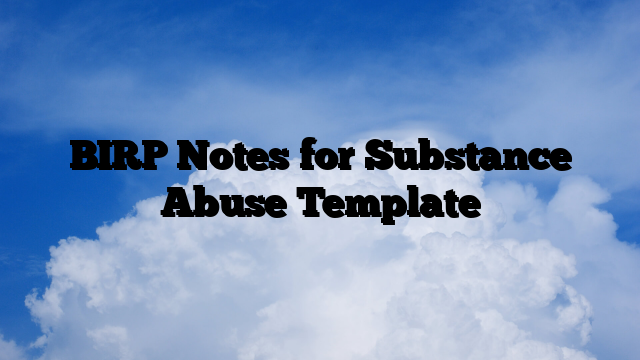Using a BIRP (Behavior, Intervention, Response, Plan) note template for substance abuse counseling can help therapists streamline the documentation process while ensuring comprehensive and structured records.
Here’s a basic BIRP notes for substance abuse template you can use and modify according to your specific requirements:
Template 1:
Client Name: [Client’s Full Name]
Date: [Date of Session]
Session Number: [Session Number]
Counselor Name: [Your Full Name]
Behavior
- Subjective Observations: [Describe the client’s attitude, mood, affect, and mental state during the session. Note any specific behaviors, comments, or expressions related to their substance abuse.]
- Objective Data: [Include any measurable or observable facts, such as results from screenings, tests, attendance records, and reported substance use.]
Intervention
- Therapeutic Techniques Used: [Detail the specific interventions or techniques used during the session, such as cognitive-behavioral therapy, motivational interviewing, problem-solving therapy, etc.]
- Topics Discussed: [Summarize the main topics or issues addressed during the session, focusing on those related to substance abuse, triggers, coping strategies, etc.]
- Client Participation: [Describe the client’s level of engagement and participation in the session, including any resistance or reluctance to participate.]
Response
- Client’s Reaction to Intervention: [Describe the client’s reactions to the interventions. Did they show insight, resistance, agreement, or discomfort? How did they respond to specific topics or exercises?]
- Progress Indicators: [Note any signs of progress or lack thereof in relation to their substance abuse. Include changes in attitude, understanding, or behavior that are relevant to treatment goals.]
Plan
- Next Steps: [Outline the plan for future sessions, including any changes in treatment approach, new interventions to be introduced, or specific topics to be addressed.]
- Homework/Assignments: [If applicable, detail any homework, readings, or activities assigned to the client to work on before the next session.]
- Goals and Objectives: [Review and adjust short-term and long-term goals based on the client’s progress and session outcomes.]
- Follow-up and Coordination: [Note any required follow-up actions, such as coordination with other healthcare providers, referrals, or contacting support groups.]
Counselor’s Signature: ______________________
Date: ______________________
Remember, the effectiveness of a BIRP note lies in its clarity and precision. It should accurately reflect the session and provide a clear direction for future sessions. Always ensure client confidentiality and comply with all relevant legal and ethical guidelines in your documentation.
Template 2:

BIRP Notes for Substance Abuse PDF Free Download
Theis Template is a comprehensive example designed for healthcare professionals, particularly those working in the field of substance abuse and addiction treatment. This free downloadable template provides a structured format for recording client interactions and progress in a clear, concise, and standardized manner.
Features:
- Behavioral Observations: The ‘B’ section of the template allows therapists to document specific client behaviors observed during the session. This includes verbal and non-verbal actions, emotional responses, and any notable changes since the last interaction.
- Intervention Strategies: Under the ‘I’ section, professionals can detail the interventions used during the session. This might include therapeutic techniques, counseling methods, and any other strategies employed to address the client’s issues.
- Response to Intervention: The ‘R’ part focuses on the client’s response to the interventions. It provides space to describe the client’s reactions, the effectiveness of the strategies used, and any progress or setbacks observed.
- Plan for Future Therapy: The ‘P’ section is for outlining the future course of action. This includes plans for upcoming sessions, adjustments to treatment strategies, and goals or objectives to be achieved.
Benefits:
- Structured Format: Ensures consistency in note-taking, making it easier to track a client’s progress over time.
- Time-Efficient: Helps therapists to quickly and efficiently document important session details, saving valuable time.
- Enhanced Communication: Facilitates better communication among healthcare providers by providing a clear and standard way of documenting and sharing client information.
- Client Progress Tracking: Aids in monitoring the client’s journey, making it easier to adjust treatment plans as needed.
Who Can Benefit:
- Substance Abuse Counselors
- Clinical Psychologists
- Psychiatrists
- Social Workers
- Rehabilitation Center Staff
- Other Mental Health Professionals
The Bottom Line:
In conclusion, the “BIRP Notes for Substance Abuse Template” is an invaluable tool for healthcare professionals dealing with substance abuse cases. By following the BIRP (Behavior, Intervention, Response, and Plan) format, clinicians can maintain comprehensive and systematic records that are essential for effective treatment planning and patient progress monitoring. This template not only ensures a structured approach to documenting patient interactions but also enhances communication among healthcare teams. It’s important for practitioners to remember that while the template provides a solid framework, each note should be personalized to reflect the unique circumstances and needs of each patient. Ultimately, the consistent use of BIRP notes can lead to more informed decision-making in substance abuse treatment, contributing to better patient outcomes and a deeper understanding of the complexities of addiction recovery.






